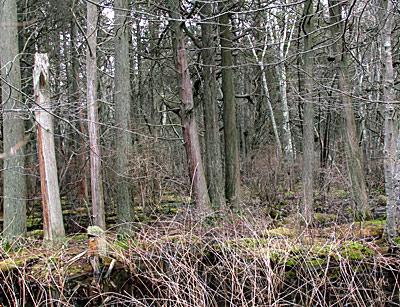Nature Notes: Persistent White Cedar

On Friday, for the second time in two weeks, I visited the largest of the three Atlantic white cedar swamps in the hamlet of North Sea with a fellow naturalist. Prior to those two visits, I hadn’t seen it since around 1983 when I visited with Rameshwar Das, who was a photographer for The East Hampton Star at the time. The swamp was too small to be protected under the state’s Freshwater Wetland Act, but not too many years later it received “special unique status” by the New York State Department of Environmental Conservation as a result of some strenuous lobbying on the part of John Turner, a Long Island naturalist and environmentalist.
In 1983, with Ramesh standing by, I cored one of the largest of the cedars, read the rings, and determined that it was about 115 years old. In other words, it was “born” shortly after the Civil War. On an 1838 United States coast map of mine only a few houses dot the hamlet of North Sea and the white cedar swamp area is labeled with the common surveyor’s symbol for wetlands, sedges.
In the 1980s visit, there were no little white cedar trees or seedlings. Almost 30 years later, the situation is the same. Inasmuch as the trees are of a similar stage of maturation, 15 to 10 inches in diameter, and similar in stature, about 75 feet tall on average, it is quite probable they comprise an even-aged stand as is the case with most of the other white cedar swamps on Long Island, which now number fewer than 15.
On the other hand, the white cedar swamp situated farthest east on Long Island, the north end of the Nature Conservancy’s Sagg Swamp Preserve, which is barely 100 feet across, had a small number of seedlings clumped in one small area in 2011.
There are three different native American species in the white cedar genus, Chamaecyparis — the Alaska cedar ranging from the interior of Oregon through coastal Washington, British Columbia, and southern Alaska, the Port Orford cedar in an areas smaller than Long Island on the Pacific Coast where Oregon and California meet, and the one in North Sea, which is spotty along the East Coast from the Gulf of Mexico north into southern Maine.
According to Thomas S. Elias’s “The Complete Trees of North America,” a field guide and natural history published in 1980, Atlantic white cedars can live to be 1,000 years old and “the light brown, lightweight, soft, close-grained wood is unmatched in its resistance to decay.” Everett Sloan in “Reverence for Wood” also praises the wood’s durability and goes on to add that cedar logs retrieved from the peat beneath cedar swamps where they fell hundreds of years earlier are still in excellent condition. In the colonial days, one widely used source of cedar shakes was the Atlantic white cedar.
One wonders why these white cedars, along with those in the great cedar swamp south of Riverhead and those from Water Mill’s Seven Ponds area and Sagg Swamp, persisted during a time when most Long Island woodlands were either burned over by wildfire or clear-cut for lumber, firewood, farm lands, or buildings. Perhaps, it had something to do with their swampy surroundings. And how is it that very similar trees growing so widely separated by almost 3,000 miles of American interior got to where they are now? Which came first, the West Coast ones or the Atlantic Coast ones? The fact that two other Chamaecyparis species are native to Japan suggests the former.
One thing is quite clear, notwithstanding the fact that there are other mature wetland trees such as tupelos and red maples in the immediate vicinity of the North Sea and Sagg Swamp white cedars: They are outsiders looking in from the edge. Because of the closely abutting cedar canopies, the interior of the cedar swamp is in shadows throughout the bulk of the day. Only when the sun is low on the horizon, as in the very early morning or before sunset, do its rays penetrate into the swamp’s interior. That is why the dominant plants on the cedar root hummocks and in the surrounding waters are almost all green mosses. Thus the origin of thick deposits of peat moss over time.
The wetland’s shrubby edge at a slightly higher elevation than the swamp itself has the aforementioned tupelos and red maples, as well as several wetlands shrubs, including maleberry, swamp azalea, sweet pepperbush, and one that is a rarity to the South Fork east of the Shinnecock Canal, swamp sweetbells.
Because of the prematurely early spring, this last shrub was already readying to bloom on Friday.
Except for a few evergreen checkerberries, i.e., redberry wintergreens, scattered here and there among the wetlands shrubs, the ground around the swamp is covered with leaf litter. Atlantic white cedars can be absolutely still, even ghostly when a slight mist is rising from the water. During the half -hour we spent at this one, not a single note from a bird was heard, and only one bird, a woodpecker, was observed. Now protected as it is by both the Town of Southampton and the D.E.C., one gets the sense that this one will last another century, at least, and maybe forever.
